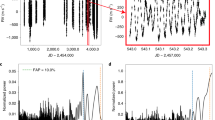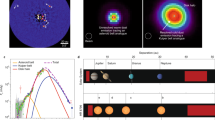Abstract
β Pictoris is the best known example of a main-sequence star encircled by a tenuous disk1. Optical2,3 and infrared4 images of β Pic suggest that the disk is composed of dust grains which have been interpreted1 as the debris generated by the disruption of the asteroid-sized remnants of planet-formation processes5. The star itself is relatively old, with an age in excess of 100 Myr. Here we present high-resolution millimetre-wave images of continuum and molecular-line emission from dust and gas surrounding a much younger star, MWC480: the stellar properties of MWC480 are similar to those of β Pic, but its age is just 6 Myr. The morphology of the circumstellar material and a comparison with the predictions of kinematic modelling indicate the presence of a rotating disk, gravitationally bound to the star. Moreover, the mass of the disk is greater than the minimum required to form a planetary system like our own5. We therefore suggest that the disk around the young star MWC480 could be a progenitor of debris disks of the type associated with older stars such as β Pic, and so holds much promise for the study of both the origin of debris disks and the early stages of the formation of planetary systems.
This is a preview of subscription content, access via your institution
Access options
Subscribe to this journal
Receive 51 print issues and online access
$199.00 per year
only $3.90 per issue
Buy this article
- Purchase on Springer Link
- Instant access to full article PDF
Prices may be subject to local taxes which are calculated during checkout


Similar content being viewed by others
References
Backman, D. E. & Paresce, F. in Protostars & Planets III(eds Levy, E. H. & Lunine, J.) 1253–1304 (Univ. Arizona Press, Tucson, (1993)).
Smith, B. A. & Terrile, R. J. Acircumstellar disk around β Pictoris. Science 226, 1421–1424 (1984).
Golimowski, D. A., Durrance, S. T. & Clampin, M. Coronagraphic imaging of the β Pictoris circumstellar disk: evidence of changing disk structure within 100 AU. Astrophys. J. 411, L41–L44 (1993).
Lagage, P. O. & Pantin, E. Dust depletion in the inner disk of β Pictoris as a possible indicator of planets. Nature 369, 628–630 (1994).
Lissauer, J. J. Planet formation. Annu. Rev. Astron. Astrophys. 31, 129–174 (1993).
Mannings, V. & Sargent, A. I. Ahigh-resolution study of gas and dust around young intermediate-mass stars: evidence for circumstellar disks in Herbig Ae systems. Astrophys. J.(in the press).
Herbig, G. H. The spectra of Be- and Ae-type stars associated with nebulosity. Astrophys. J. Suppl. Ser. 4, 337–368 (1960).
Aumann, H. H.et al. Discovery of a shell around α Lyr. Astrophys. J. 278, L23–L27 (1984).
Sylvester, R. J., Barlow, M. J., Skinner, C. J. & Mannings, V. Optical, infrared and millimetre-wave properties of Vega-like systems. Mon. Not. R. Astron. Soc. 279, 915–939 (1996).
D'Antona, F. & Mazzitelli, I. New pre-main-sequence tracks for M ≤ 2.5M⊙ as tests of opacities and convection model. Astrophys. J. Suppl. Ser. 90, 467–500 (1994).
Koerner, D. W. in CO: Twenty-Five Years of Millimeter-Wave Spectroscopy(eds Latter, W. B. et al.) 162–164 (IAU Symp. 170, Kluwer, Dordrecht, (1997)).
Scoville, N. Z.et al. High-resolution mapping of molecular outflows in GGC 2071, W49, and NGC 7538. Astrophys. J. 303, 416–432 (1986).
Hildebrand, R. H. Determination of cloud masses and dust characteristics from submillimetre thermal emission. Q. J. R. Astron. Soc. 24, 267–282 (1983).
Beckwith, S. V. W. & Sargent, A. I. Particle emissivity in circumstellar disks. Astrophys. J. 381, 250–258 (1991).
Mannings, V. & Emerson, J. P. Dust in disks around T Tauri stars: grain growth? Mon. Not. R. Astron. Soc. 267, 361–378 (1994).
Draine, B. T. & Lee, H. M. Optical properties of interstellar graphite and silicate grains. Astrophys. J. 285, 89–108 (1984).
Miyake, K. & Nakagawa, Y. Effects of particle size distribution on opacity curves of protoplanetary disks around T Tauri stars. Icarus 106, 20–41 (1993).
Pollack, J. B.et al. Composition and radiative properties of grains in molecular clouds and accretion disks. Astrophys. J. 421, 615–639 (1994).
Wright, E. L. Long-wavelength absorption by fractal dust grains. Astrophys. J. 320, 818–824 (1987).
Beckwith, S. V. W., Sargent, A. I., Chini, R. S. & Güsten, R. Asurvey for circumstellar disks around young stellar objects. Astron. J. 99, 924–945 (1990).
Koerner, D. W., Sargent, A. I. & Beckwith, S. V. W. Arotating gaseous disk around the T Tauri star GM Aurigae. Icarus 106, 2–10 (1993).
Dutrey, A., Guilloteau, S. & Simon, M. Images of the GG Tauri rotating ring. Astron. Astrophys. 286, 149–159 ((1994)).
Beckwith, S. V. W. & Sargent, A. I. Circumstellar disks and the search for neighbouring planetary systems. Nature 383, 139–144 (1996).
Sargent, A. I. in Disks & Outflows around Young Stars(eds Beckwith, S. V. W., Staude, J., Quetz, A. & Natta, A.) 1–23 (Springer, Berlin, (1996)).
Dent, W. R. F., Greaves, J. S., Mannings, V., Coulson, I. M. & Walther, D. M. Asearch for molecular gas components in prototypal Vega-excess systems. Mon. Not. R. Astron. Soc. 277, L25–L29 (1995).
Beust, H. & Lissauer, J. J. The effects of stellar rotation on the absorption spectra of comets orbiting β Pictoris. Astron. Astrophys. 282, 804–810 (1994).
Weidenschilling, S. The origin of comets in the solar nebula: a unified model. Icarus(in the press).
Acknowledgements
V.M. thanks M. Romans and N. Romans for their support. We thank the staff at the Owens Valley Radio Observatory for their assistance. The Owens Valley millimetre-wave array is supported by the NSF; array studies of young star and disk systems are supported in part by the Norris Planetary Origins project and by NASA's Origins of Solar Systems programme.
Author information
Authors and Affiliations
Corresponding author
Rights and permissions
About this article
Cite this article
Mannings, V., Koerner, D. & Sargent, A. A rotating disk of gas and dust around a young counterpart to β Pictoris. Nature 388, 555–557 (1997). https://doi.org/10.1038/41505
Received:
Accepted:
Issue Date:
DOI: https://doi.org/10.1038/41505
This article is cited by
-
Herbig Stars
Space Science Reviews (2023)
-
Accretion disks in luminous young stellar objects
The Astronomy and Astrophysics Review (2016)
-
Study of the inner disk of the Herbig star MWC480
Astrophysics and Space Science (2015)
-
The outer disks of Herbig stars from the UV to NIR
Astrophysics and Space Science (2015)
-
Water vapour and hydrogen in the terrestrial-planet-forming region of a protoplanetary disk
Nature (2007)
Comments
By submitting a comment you agree to abide by our Terms and Community Guidelines. If you find something abusive or that does not comply with our terms or guidelines please flag it as inappropriate.



